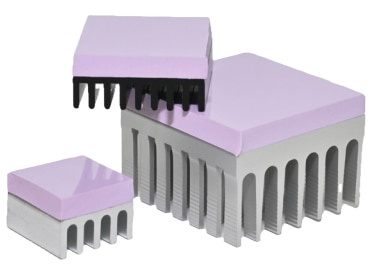Ultra-Soft Thermal Pads for Heat Management Applications
Contributed By DigiKey's North American Editors
2025-07-16
Servers are ubiquitous in IT infrastructure and play a critical role in cloud and enterprise computing data centers. But the processors, GPUs, storage drives, and power supplies for these servers generate heat. To dissipate it, an elaborate set of cooling mechanisms, including air and liquid-based processes, channel it away to prevent hardware malfunctions and suboptimal performance.
The role of thermal pads in servers
As computing demands rise, data centers are packing more server racks into tighter spaces—driving up overall heat density and increasing the risk of hotspots. Without effective thermal management, components can enter thermal throttling, which degrades performance, accelerates hardware failure, and contributes to premature system malfunctions.
Heat sinks are commonly used to dissipate heat from components such as processors. But between components and their heat sinks, even very small air spaces can impede thermal conduction. This is where thermal pads come into play.
Comprised of a thermal interface material (TIM), thermal pads help transfer heat away by forming a layer between a heat source and a heat sink. They are made of thermally conductive materials that can be molded to fit into the interstitial spaces or air gaps, facilitating heat transfer between the server components and a heat sink or cold plate. They replace air with more thermally conductive materials and conform to surface irregularities. Importantly, the TIM must fill the voids without interfering with the electronic component’s performance.
Thermal pads are especially useful in dense server racks because of a number of their features:
- Conformability: Thermal pads can be molded to the shape needed to effectively fill air gaps. Doing so decreases resistance and helps transfer heat away. Some thermal pads are almost putty-like in their consistency, allowing them to fill voids more effectively and ensuring better surface contact and optimized heat transfer.
- Low assembly pressure: Delicate hardware components are protected because the pads do not require excessive pressure for thermal contact.
- Consistent performance and ease of handling: Unlike thermal greases, which require frequent reapplication and can be displaced, thermal pads maintain reliable performance over time, even at high temperatures. Phase-change materials, another type of TIM, are fragile, and thermal pastes and greases are messy.
The TG-AD Series ultra-soft thermal pads
The TG-AD Series ultra-soft thermal pads from T-Global Technology offer an ideal combination of low hardness, high thermal conductivity, and good electrical insulation, making them a strong option for thermal management in data centers and other computing environments. The pads are able to conform to the microscopic irregularities between mating surfaces.
The TG-AD series can be supplied in standard sheets or as custom die-cut parts, with thicknesses ranging from 1 mm to 8 mm. They offer long-term, reliable performance and are primarily targeted to the server industry, particularly in applications where precision thermal management and surface compliance are critical.
The TG-AD series has several properties that make it a superior TIM. These include:
- Ultra-low hardness and high conformability: The silicone-based matrix, which forms the primary component of the TG-AD series, makes the pads very soft. Products are measured on the Shore 00 hardness scale for very soft materials, which ranges from 0 (very soft) to 100 (firm).
- The pads deform easily, even under very low pressure, allowing design engineers to ensure contact between components and heat sinks with minimal force. Such mechanical compliance is especially valuable when working with components that have irregular surfaces or varying heights, such as voltage regulator modules (VRMs) or ball grid array packaging.
- High thermal conductivity: The silicone matrix in the TG-AD series includes ceramic fillers, which are excellent heat conductors. Thermal conductivity is measured in watts per meter-kelvin (W/mK), indicating the efficiency of heat transfer. The higher the number, the faster and more efficiently heat moves from one side of the thermal pad to the other.
- Customizable thickness and formats: In addition to being available in a range of thicknesses, the TG-AD series can be customized to fit components precisely, allowing design engineers to match the thermal pads to their exact needs.
The TG-AD series includes the following lines:
The TG-AD30 (Figure 1), which has a thermal conductivity of 3.0 W/mK and a Shore 00 hardness of 20.
 Figure 1: The TG-AD30 ultra-soft thermal pad is formulated to achieve exceptional void filling between components and heat sinks with only a light amount of pressure, providing low thermal impedance. (Image source: T-Global Technology)
Figure 1: The TG-AD30 ultra-soft thermal pad is formulated to achieve exceptional void filling between components and heat sinks with only a light amount of pressure, providing low thermal impedance. (Image source: T-Global Technology)
The TG-AD66 (Figure 2), which has a thermal conductivity of 6.6 W/mK and a Shore 00 hardness of 25.
 Figure 2: The TG-AD66 can be supplied in either standard sheets or custom die-cut parts in thicknesses ranging from 1.0 to 8.0 mm. (Image source: T-Global Technology)
Figure 2: The TG-AD66 can be supplied in either standard sheets or custom die-cut parts in thicknesses ranging from 1.0 to 8.0 mm. (Image source: T-Global Technology)
The TG-AD75, which offers a thermal conductivity of 7.5 W/mK with a Shore 00 hardness of 25 (Figure 3).
 Figure 3: The TG-AD75 ultra-soft thermal pad is a set of high-performance silicone gap pads with a thermal conductivity of 7.5 W/mk.
Figure 3: The TG-AD75 ultra-soft thermal pad is a set of high-performance silicone gap pads with a thermal conductivity of 7.5 W/mk.
All products are RoHS and REACH compliant and can be supplied in either standard sheets or custom die-cut parts, with thicknesses ranging from 1 mm to 8 mm.
Selecting the right thermal option
The TG-AD thermal pads can be used in various data center and server applications, including processor and GPU cooling, memory modules, and VRMs, providing thermal management in increasingly high-density environments. Edge servers and microservers, which have limited airflow and constrained mechanical tolerances, can also benefit from the use of thermal pads.
Selecting the right thermal pad for a specific application typically requires careful consideration of the operating conditions and the balance that design engineers are willing to strike between various characteristics.
Factors to consider when selecting a thermal pad include:
- End application and operating environment: While most server racks have similar operating conditions, it is still essential to understand that the thermal pads can withstand the temperatures, dust, and vibrations that the equipment will likely encounter.
- Conductivity: The usual recommendation is first to select the conductivity and then the hardness. T-Global offers a handy chart for zeroing in on the right combination.
- Thickness: Thinner sheets will have slightly better conductivity, but thicker pads can fill larger gaps and better conform to uneven surfaces. T-Global recommends using thicker pads when mechanical tolerances are high.
- Dielectric strength: Electric isolation might sometimes be necessary to protect components. Thermal pads with a high dielectric strength will prevent electrical shorts, which can lead to system failures. Harder pads or reinforced pads with fiberglass usually have better dielectric strength.
Conclusion
Selecting the right thermal pad helps designers bridge the gap between heat-generating components and their associated cooling elements. The TG-AD Series ultra-soft thermal pads from T-Global Technology help keep server racks and data centers cooler, thereby increasing their life and durability.

Disclaimer: The opinions, beliefs, and viewpoints expressed by the various authors and/or forum participants on this website do not necessarily reflect the opinions, beliefs, and viewpoints of DigiKey or official policies of DigiKey.







